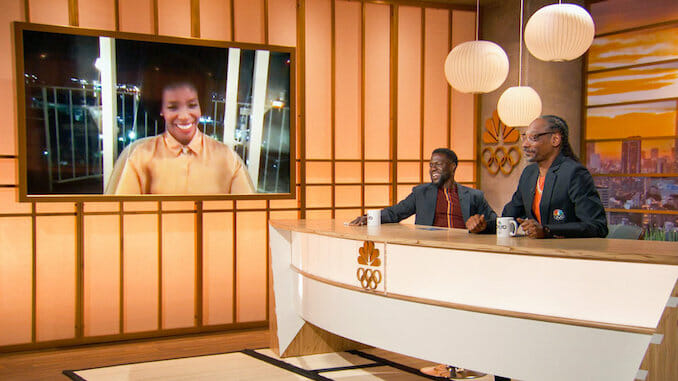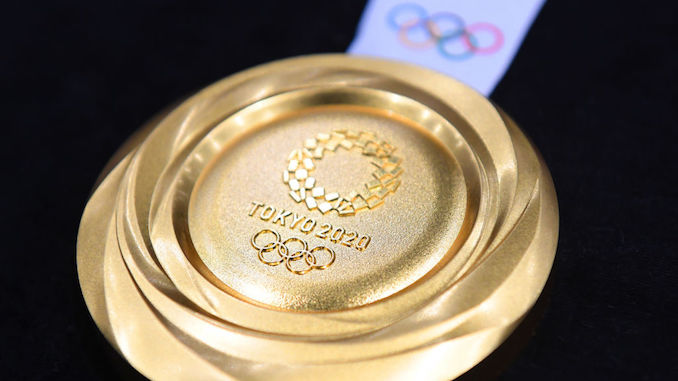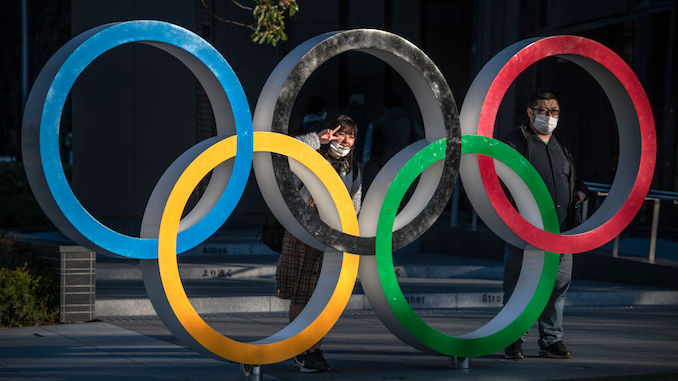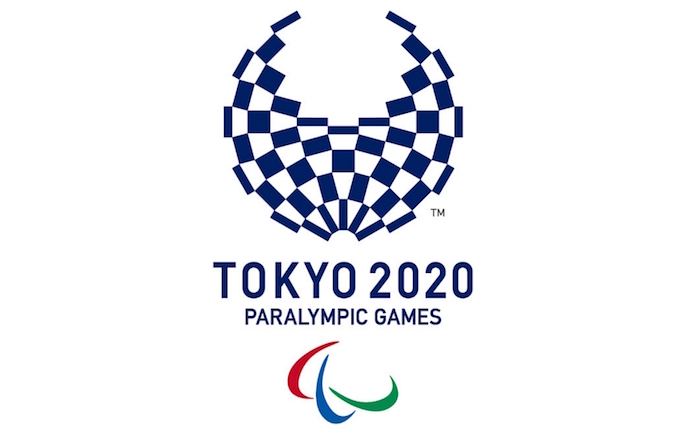4 Winners, 2 Losers, and 1 DNF from NBC’s Coverage of the Tokyo Olympics
Nevertheless, it persisted.
Photo Courtesy of Peacock TV Features Tokyo Olympics
Even if you’re not particularly sports-inclined, it’s difficult to avoid getting sucked into at least a bit of the global endorphin rush that is the Olympic Games. Is this an ethical state of affairs? Probably not. But where the Games themselves are a tangle of morally gray capitalist complicity, the feats of athletic excellence on the field, and the displays of joy and mutual support between both individual competitors and whole national teams, is nevertheless worth celebrating. Plus, this year the IOC added all the cool kid sports (surfing, skating, sport climbing), and NBC made remarkably lofty promises about the Olympic experience it was set to deliver cord-cutters via Peacock. How could we (read: I) not watch?
Well, with the Summer Games torch now officially passed off to Paris (with a pit stop in space!), we (read: I) have jotted down a few thoughts on the biggest winners and losers in the television experience that was 2021’s Tokyo 2020 Summer Olympics, and that has yet to be 2021’s Tokyo 2020 Summer Paralympics.
Spoiler: Peacock does not come out looking great.
![]()
WINNER: Teens (& Their Occasional Record-Breaking Elders)
I’m sure there was any number of other trends I might have picked up on, but longtime readers of Paste’s TV coverage aren’t likely to be surprised that the one *this* writer picked up on was just how chockablock so many of the podiums were with amazing (and amazingly athletic) teens. Obviously you had Suni Lee (18) winning the women’s all-around gymnastics gold, and Lydia Jacoby (17) setting her sights on Ledecky’s swimming legacy with her women’s 100m breaststroke gold. But you also had Nevin Harrison (19) taking an historic gold medal in the first ever women’s C-1 200m canoe sprint, Athing Mu (19) breaking Ajee’ Wilson’s world record to win gold in the women’s 800m track event, Alberto Gines Lopez (18) shocking the climbing world by taking the first ever men’s all-around sport climbing gold, and Quan Hong Chan (14) knocking down perfect 10 after perfect 10 in the women’s diving final. More incredible still, the fact that both podiums in the two women’s skateboarding events ending up stacked with teens: Nishiya Momiji (13), Rayssa Leal (13) and Funa Nakayama (16) taking the top three spots in street, and Sakura Yosozumi (19), Kokoma Hiraki (12!) and Sky Brown (13) taking the same in park. And that’s all without even counting the teens who made it to the finals and/or podium in the events I missed. Truly, Tokyo 2020 was made for teens.
AND YET. And yet! History kept being made, throughout the Games, at the other end of the age spectrum. In women’s kata (one of the two karate events making its temporary debut in the Olympics this year), Spain’s Sandra Sanchez Jaime became her country’s oldest Olympic champion, at 39 and 11 months. Over on the women’s individual vault, meanwhile, Uzbekistan’s Oksana Chusovitina closed out her Olympics career at age 46, while in the men’s skateboard park event, Denmark’s Rune Glifberg launched his Olympics career at the same age. Perhaps most exciting to mainstream American sports fans, though, will be this last pair: In leading Team USA to its own seventh-consecutive gold medal in Saturday’s women’s basketball final against Japan, Sue Bird (40) and Diana Taurasi (39) became the only basketball players, women’s or men’s, to have won a total of five gold medals.
In short, the extremes these Olympics made possible are all just rad. Love it. No further notes.

LOSER: Peacock
Don’t get me wrong: Every goofy Olympics-related bit Amber Ruffin brought to Peacock’s Summer Games coverage was an absolute delight. (All the golds for Amber Ruffin, please!) Kevin Hart and Snoop Dogg’s odd-couple highlights host banter, too, ended up being charming as hell to tune in to. (Like, you could have a full Olympics experience without hearing Snoop introduce himself as “the world’s foremost expert on dressage [shout-out to all my ponies],” but it’s hard to imagine you would *want* to.)
Everything else, though? The long-delayed replays? The chaotically edited, context-free “highlights” clips? The basic fact that, contrary to what the brass at NBC Universal said before the Games began, most of the 2020 Olympics events didn’t end up being available, on replay or live, with a Peacock subscription alone? An Olympics-sized nightmare!
And it’s not like Peacock wasn’t set up for success. Rather than having mere months to pull off a streaming Olympics miracle, like they would have done if the Games had gone on as planned last summer, they had an entire extra year. Moreover, with ratings down across NBC Universal’s more traditional broadcast channels; the moment really was ripe for Peacock to pull off something great. Instead, would-be viewers—your expert Paste TV team included!—were left crowdsourcing replay schedules to get their USA Softball fix, and snagging temporary NBC Sports access via their cousin’s roommate’s parents’ cable log-in to watch immediate (but clunkily uploaded) full-length replays of everything from 3×3 basketball to sport climbing. And don’t even get me started on the absolute inanity of Peacock running “Watch Now” promos in which two out of the five series featured, Dan Brown’s The Lost Symbol and One of Us is Lying, are *literally* months away from premiering. Why!!!
Look, I know it’s beyond cliché at this point, but man, Peacock—you had one job.
That said, Beijing 2022 is just around the corner. And you know what, Peacock? I’m rooting for you. Or at least, I’m rooting for Amber. But if you can keep her on the coverage team and build the perfect Olympics streaming experience? There will absolutely be a gold (viewership number) medal with your name on it.
WINNER: Old-Fashioned Cable Surfing
Incredibly, Peacock’s utter failure to deliver elite streaming Olympics access this time around did clear the way for one (perhaps surprising) winner: Good old-fashioned cable!
Not to ascribe any powers of premonition to Paste’s inimitable TV editor, but one thing these last two weeks of broadcast Olympics coverage made abundantly clear is, there’s sometimes just no substitute for channel surfing. Two of the greatest joys of the Olympics, after all, are getting to fall wildly in love with the most random of sports (canoe slalom! handball! trampoline!), and getting to develop sudden and wholesome obsessions with the most unexpected of athletes (Raven Saunders! Tom Daley! Bryce Wettstein!) The thing is, you can’t really do either without a solid dose of serendipity, and as Allison alludes to in her piece on the limitations of streaming, it’s hard to manufacture the same sense of random chance that just… happens when surfing cable television. With NBC Universal running Olympics coverage across NBC, USA, NBC Sports, Telemundo, The Golf Channel and (I’m not kidding) CNBC, though, the very best kind of Olympics serendipity was in full supply for the last couple of weeks. Like, would I have used Peacock to seek out the middle third of the men’s archery qualifiers, or the last heats of the women’s C-1 200m canoe sprint semis, or the back half of the mixed triathlon finals all on my own? No! I absolutely would not have! Did I end up loving every second I watched, after stumbling onto all three? Yes! I absolutely did!
All of that to say: Surfing! It’s not just for pros like Carissa Moore.

LOSER: Tokyo
On the one hand, the show that Tokyo eventually put on for these Olympics was solid. The opening and closing ceremonies, both, were filled with stirring performances and exciting displays of technological prowess—between the opening ceremony’s drone-made sparkling globe and the closing ceremony’s TV-only glittering, upward-cascading Olympic rings, it’s hard to imagine what either Beijing or Paris might do to top Tokyo’s glitz.
On the other hand, though, is… everything else. There was the Covid of it all, of course, both within the Olympic Village and in Tokyo at large. On that front, the IOC is officially reporting 458 cases (as of August 9), while Tokyo as a whole has seen its 7-day average rise from 1,346 on July 23 (the start of the Games) to 3,883 on August 7 (the end). Not to be outdone, the inexorable forces of climate change saw historic and truly dangerous heat hit the games, bringing athletes close to heat stroke in some cases, and forcing entire events to be cut short in others. And all of this, of course, comes on top of the Olympics having proven themselves to be a dependable financial boondoggle for just about every host city, even in years when a global disease pandemic isn’t warring with an historic climate crisis to keep normal tourist revenue from offsetting at least part of that investment. Not great!
So, I’m sorry, Tokyo. You are a beautiful city filled with talented artists, a vibrant culture, and what appears to be an almost endless supply of world-class skateboarding and sport climbing athletes. You deserved better than the 2020 Olympics.
WINNER: Making Falling an Olympic Sport
One of the bigger storylines attached to this year’s-last summer’s Olympics is the addition of several especially flashy new sporting categories: surfing, skateboarding and sport (aka, rock) climbing.
Delightfully, these three sports are, by their very nature, not just loci for demonstrations of physical prowess, but also activities in which falling and/or failing half or more of the times you’re out there isn’t just normal—it’s expected. (The BMX event, which added a freestyle discipline this year, is cut from the same scuffed-up cloth.) I may not have everyone on my side for this, but I find the addition of this kind of vibe to the Olympics just endlessly great. I mean, being an elite athlete at the top of their game is a situation very few of us will ever find ourselves in. But falling? And having the mental grit to bounce back up and keep trying? That’s some elite Olympic athlete shit we can all strive to emulate.
(This it’s-okay-to-fall mindset, not for nothing, ties in pretty directly to everything that happened with Simone Biles, too. See Shane Ryan’s empathetic reaction to that situation here for more.)
DNF: Tokyo 2020’s Efforts Towards “Gender” “Equity”
If you spent more than, say, half an hour watching this year‘s Games, you’ll likely have heard the commentators reference the fact that Tokyo 2020 was slated to be the most gender-equal Olympics to date, with women representing a full 49% of the 11,090 qualifying athletes—up 4% from 2016’s split. The IOC set out to achieve this very deliberately, both proactively balancing out the number of men’s and women’s events available—the 1500m race Katie Ledecky crushed this year, for example, had only previously been available as a men’s event, as had the 3×3 basketball event the Kara Lawson-coached USA women just took home gold in—and working aggressively to ensure that at least one male and one female athlete would be representing each participating country. The addition of more mixed events helped, too (mixed triathlon being a particular standout), as did the fact that each of the four new events added this year—surfing, skateboarding, sport climbing and karate—included an equal number of events for men and women, alike. Even on the broadcast front, it felt like female representation was looking up, with Kathryn Tappen holding down the fort on NBC proper, Maria Taylor taking over on CNBC, and Kara Lawson pulling double-duty calling the women’s 5-on-5 basketball games after leading her own team to that aforementioned 3×3 gold.
(Paris, for its part, is predicting full female/male parity for the Summer Games in 2024, setting a new historic record for itself after becoming the first Games in modern Olympic history to welcome women at all—2.2%, in 1900.)
That said, if you watched the Games for any longer than, say, a half hour, you were just as likely to be reminded of just how much further even the most basic take on “gender equality” has to go. It was jarring, for instance, to hear one set of (male) commentators describe one of the world’s best beach volleyball players as “the Elon Musk of beach volleyball: fearless, ambitious, and not afraid to send things up into space,” only to flip to another channel to hear a different set of (also male) commentators say of the best women’s canoe slalomers, “both of these girls will do well [in the finals].” Equally frustrating was the fact that, while the four new events themselves had an equal men’s/women’s split, the judging panels were almost overwhelmingly male. (Just one woman sat on both skate event panels, for example, while zero sat on the sport climbing one.)
And all of this is before taking into account the experience (or forcible lack thereof) of athletes whose gender sits outside the cis-male/female binary. Yes, Team New Zealand’s Laurel Hubbard made history as the first out trans athlete to qualify for the Olympics overall, and yes, Team USA’s Alana Smith (skateboard – street) and Team Canada’s Quinn (soccer) made their own history as the first non-binary athletes to qualify (in Smith’s case) and win gold (in Quinn’s). But at the same time, the IOC’s punishingly narrow trans-inspired testing protocols kept at least three African sprinters out of this summer’s Games—Namibian track and field stars Christine Mboma and Beatrice Masilingi (both 18!) and South African middle distance runner Caster Semenya. Worse still, rather than signaling any kind of improvement for future games, a small but viciously vocal minority of anti-trans critics have the IOC suggesting they’ll pursue even greater hormone-limiting stringency moving forward.
Again I say: Not great!

WINNER: The Tokyo 2020 Paralympics
One of the greatest things about the Olympics, in terms of its global role as an obsession-making bi-annual event, is that, even when the Games are over, they’re not actually over. Why? Because of the Paralympics, which launch mere weeks after the abled-Olympics wrap up. (Though this year the feeling that the Olympics never truly end feels doubly true, as the Beijing 2022 Winter Games are literally… six months away.)
Launched initially in 1948 by a Dr. Ludwig Guttman as a narrowly-focused competition of British WWII vets-turned-wheelchair athletes, the Paralympics as we know them have been running in tandem with the Summer and Winter Olympic Games since the Seoul Games of 1988. This year, the Paralympics will consist of 22 events (one of which, cycling, is split into two disciplines), and will feature 3,319 athletes representing 133 different countries/coalitions (referred by the Games themselves as National Paralympic Committees, or NPCs). If you watched the last two weeks of Tokyo 2020 coverage on anything at all ad-supported, you’ll already have become familiar with several of Team USA’s biggest stars, including Allysa Seely (a gold medal paratriathlete) and Jessica Long (a 13-time gold medal swimmer), who both featured heavily in shiny ads for Emgality and Toyota. If you’re looking for even more faces to follow, though, NBCOlympics.com has an entire Paralympics home page, where they’ve put together multiple sharp pre-air packages.
On that note, NBC is going big on all its Paralympics coverage this year, with plans to air 200 hours of events coverage in NBC primetime, and 1200 hours across all NBC Universal platforms. While NBC’s Olympics coverage has been, well, as good as one might hope for in recent years, the same hasn’t necessarily been true of it’s coverage of the Paralympics—with this year’s Games, they aim to change that.
Of course, that doesn’t necessarily mean the Paralympics will be any easier to keep up with than the Olympics, themselves, were. Whatever strategy NBC set for their Olympics coverage these last two weeks, they’re unlikely to have changed much for their Paralympics coverage, which starts Sunday, August 24. That said, NBCOlympics.com is again at least trying to come in clutch, with a basic guide to the Paralympics on TV here, and a more comprehensive guide to all the platforms coverage will be able to be found on here.
Definitely click through for more details, but in case you just want the three biggest highlights, here you go:
— NBCSN will televise the Tokyo Paralympics from 9 p.m. – 9 a.m. ET daily, with additional original hours and extensive replays on Olympic Channel: Home of Team USA. NBCSN will present live coverage of the Opening Ceremony on Tuesday, August 24, and live coverage of the Closing Ceremony on Sunday, September 5.
— Peacock will feature medal round action in multiple sports, including men’s and women’s Wheelchair Basketball and Women’s Sitting Volleyball, all three of which were won by Team USA at the 2016 Rio Paralympics, plus Wheelchair Rugby and Marathon races.
— Accessibility features for all television coverage include closed captioning (CC) and video description services (VDS) to assist viewers in experiencing the accomplishments and stories of the Paralympic athletes.
Peacock! Again! Well, like I said: I’m rooting for them. For them, and for the Paralympians about to run (and swim, and row, and judo) their hearts out. I can’t wait for August 24.
All Tokyo 2020 Olympics events are now (at least temporarily) streaming, in part or in full, across Peacock, NBC Sports, Telemundo, the NBC YouTube channel, and NBCOlympics.com. Coverage of the Tokyo 2020 Paralympics will begin August 24 on NBC primetime, and will run through September 5.
Alexis Gunderson is a TV critic and audiobibliophile. She can be found @AlexisKG.
For all the latest TV news, reviews, lists and features, follow @Paste_TV.